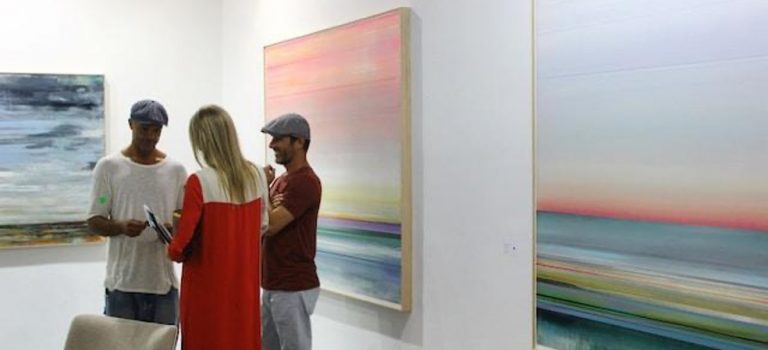Source: Art Business News.
L’art pour l’art (art for art’s sake) is no more. Today, striving artists face a single choice: integration or isolation. And it’s hard. Today’s supreme vacuum of personal creativity gets intertwined with a corporate-like model of success. An intricate patchwork, to say the least. We now recognize networking as the sole vessel of one’s creative triumph.
Are you in, or are you out?
NETWORKING: A STAIRWAY TO SUCCESS
Getting out of your creative bubble and employing your soft skills can be nerve-racking. Let’s debunk the beauty of networking straight away: it’s awkward and often excruciatingly unpleasant (due to the “I’m only here to use you” – and vice versa narrative). For any genuine artist, entertaining the idea of mingling for work’s sake is nearly blasphemous, as it takes them away from the only thing that actually matters – creating. However, the harsh truth is: our art can only change the world if it’s being seen and consumed by another. So, yes, networking is paramount. It’s how we land gigs, establish collaborations, and build a future-proof client base. Proactive is the new artistic mindset. Omnipotency. Soft and hard skills combined. How do we establish new connections? By crashing the network party, even if our landing strategy may need some practice, granted.

Image by Frankie Cordoba for Unsplash
THERE’S NO WAY AROUND IT
You can tiptoe through the tulips with Tiny Tim all you want; without networking, there are no opportunities on the table. Buffet? Forget it. How do you get into a gallery? Not by embodying a virtual recluse. Not anymore, not today. Surely, it all seems too familiar, a PTSD “high school integration drama series” rated PG 18. As we get more mature (and that extra existential patina kicks in), getting to know people becomes more challenging by the minute. Social butterfly? Unlikely. Porcupine? Best case scenario. Nonetheless, networking has statistics on its side. 95% of people in the art industry confirm that good, archaic face-to-face meeting is still pivotal in creating the necessary connections.
DON’T OVERSELL IT
Nobody likes the “The artist is present” approach. If you’re entering the networking waters, be sure to silence the aggressive-seller trait. It’s not cute. And it doesn’t work. It may sound counterintuitive, but the more we try, the worse it gets. Think of networking as an audition. In other words, the people you are trying to get acquainted with and befriend are looking for that relatable thread. It’s not about establishing control and holding the discourse reins; it’s just social interaction. Plain and simple. Therefore, lose the internal pressure. “Tonight’s the night. You’re going to make it.” Probably not. Networking is a slow process and if you’re in it for the long haul, you better learn to enjoy it for what it is, not for what it can do for you.
Like speed dating but for artists, therefore, the idea is to lay the creative network foundation, and opportunities will organically follow.

Image by Geri Mis for Unsplash
LEAVE NO STONE UNTURNED
What does networking in the art industry entail? Think big picture. Keep an open mind. Just because you are a painter doesn’t necessarily mean your network circle should solely include painters. It’s just too tautological, no? Too convenient. Too illiberal, borderline conservative, in a sense. Talk to everyone and leave no stone unturned. Patrons enjoy a good disguise these days. Furthermore, you never know from whose nods of approval your art could benefit the most – unless you spread those wings, butterfly. Branching out is the key. The mother of networking. “But we don’t share a common denominator.” So? You’d be surprised. Make connections and contacts with individuals working in other industries; these often make the best project collaborations. Lose the skepticism. Go for it.
PRACTICE THAT PITCH
The infamous ride or die: the elevator speech. “So, tell me, what brings you here tonight? What do you do for a living?” And it’s ready, set, go. This is your shot. So, what do we do? We don’t panic. And we have a pitch ready. Memorized, if need be (especially for the ones with paralyzing stage fright). Keep it casual, brief, and always to the point. Keep your verbal hook under one minute; provide your interlocutor with valuable information – what makes your work so intriguing and HQ? Too door-to-door sales for you? Maybe, all the same, it’s too potent to be put out of business. Art marketing rides on one’s ability to sell the work. To sell the artist (i.e., your masterful self). What are you going to do with all that unsold artwork? Exactly.
TO BRING THAT PITCH TO PERFECTION
Practice beforehand (giggle away, it’s solid advice). Come up with a memorable, idiosyncratic introduction. Make the pitch unique, yours. You’re an artist, no? Idiosyncrasy is your playground. Use it to your advantage. Schedule a roleplay date with your friends (not that kind, silly). Practice the pitch. The simulation will come in handy. Or, if you’re feeling too introspective, there’s always a mirror around. The Shakespeare hour unfolds. P.S. Be sure to time it.
LASTLY
It’s not all social anxiety and climbing-the-ladder turmoil. Networking in the art industry can be a lot of fun. Only if you know how. So, practice offline and online networking simultaneously. Do: TikTok, Instagram, LinkedIn, Twitter, Facebook. Find artists who are well-connected within the niche of interest. Who do you see yourself collaborating with? Reach out via social media platforms. Charm your way up. Finally, don’t consider your competitors your nemesis; you can learn from them – and vice versa. Connect.








